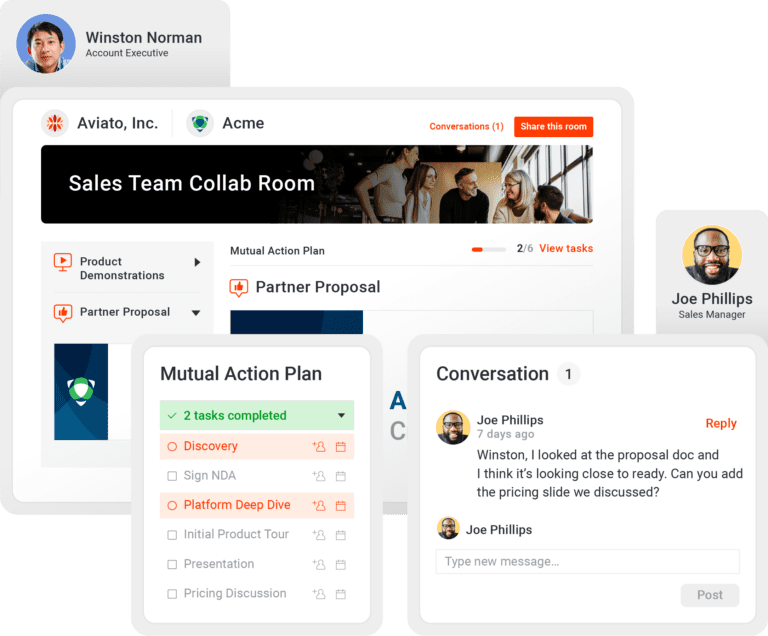Content Governance: What is it and Why is it Important?
![]() Christian Pieper
on
November 5, 2024
Christian Pieper
on
November 5, 2024
Content undoubtedly plays an important role in the B2B purchase journey. According to recent research, over half of B2B buyers rely on content to guide their purchase decisions more now than in the past.
But revenue organizations experience content chaos all too often. Sales content is poorly organized in disparate systems, and sellers spend much time looking for what they need. They may also take matters into their own hands and create their own unapproved content.
Content chaos stifles seller productivity and puts your organization at risk. Every revenue organization must have a governance strategy and the right tools to support it.
If you’re unsure what corporate governance is, you’ve come to the right place. In this post, we’ll answer questions like:
- What is content governance?
- Why is it important?
- How can my organization build a content governance framework that calms the content chaos?
What is content governance?
You might find yourself asking, “What is content governance?” You’re certainly not alone.
It describes the framework, processes, and policies for effectively overseeing all aspects of your sales content strategy.
A content governance strategy encompasses everything from creating and maintaining sales content, organizing and dispersing it, and measuring engagement and impact to inform optimizations.
The ultimate goal of a content governance framework is to ensure sellers can access and share high-quality, accurate, approved content that resonates with every buyer, no matter where they are on the purchase journey.
Proper content governance requires the right tools. An excellent sales content management solution is a must.
What are the benefits of content governance?
Content chaos is all too common. A content governance strategy can help calm the chaos.
Let’s look at some of the top benefits of content governance.
Better cross-functional alignment
Today, most go-to-market leaders understand the importance of sales content. But often, there’s confusion about who is responsible for what.
With a content governance framework, there is alignment on roles and responsibilities. Furthermore, everyone uses the same guidelines, allowing consistency across all sales content.
Increased seller productivity
Sellers spend countless hours hunting down the right, most up-to-date content. This time could be better spent engaging with buyers and closing deals.
One key benefit of content governance is that it boosts seller productivity. When sellers can easily find relevant, updated resources, they can spend less time hunting down content and creating their own unapproved assets. Then, they can use that time doing what they do best: selling.
Better buyer experiences
If a seller shares inaccurate content with a buyer, that buyer will likely lose trust in your business. If the buyer receives inconsistent content, it can lead to confusion.
A content governance framework ensures all sales content is accurate and on-brand. That means buyers will always have accurate information and consistent content experiences. This will build their trust and increase their likelihood of making a purchase.
Risk mitigation
If you don’t have a content governance strategy, your sellers are likely using outdated or unapproved sales content. For example, a seller might save a piece of content to their desktop and continue to send that version – even though it’s been updated a few times. Or, they might create and send unapproved content.
This is risky for any organization. If buyers get their hands on outdated or sloppy content, it can cause reputation damage. It’s especially risky for organizations in highly regulated industries like financial services or pharmaceuticals.
With a proper content governance framework, you can be sure your sellers only use approved, on-brand content.
Actionable insights
Often, organizations invest time and resources into developing sales content. But many lack insight into how sales content is used.
With a content governance strategy (and the right tools) you’ll have insight into how buyers and sellers engage with sales content – and how it improves outcomes. These insights can help you optimize your strategy and allocate your resources.
How to get started with content governance
Content governance can help you overcome content chaos for once and for all. But how can you get started?
There is no one-size-fits-all content governance framework that works for every organization. Instead, it looks different at every organization.
However, there are certain steps every organization must take when developing an effective content governance framework.
Create your content governance task force
A single person or team doesn’t own content governance. Instead, it must be a cross-functional effort.
Be sure to gather your content governance task force. Then, work to ensure everyone is aligned on content governance goals, roles, and responsibilities.
Develop workflows and processes.
Once you’ve established your task force, you can work collaboratively to establish workflows and processes to govern content across the entire lifecycle. This includes:
- Content planning: What content will be created, and who can submit ideas and suggestions for new content?
- Content creation: Who will be involved in the development of content?
- Content design: Who is responsible for designing content?
- Content approval: Who needs to approve content, and what processes will be needed to get these approvals?
- Content distribution: How content will be shared with sellers and how you’ll ensure they know where to find sales content and how to properly use it.
- Content measurement: What metrics and tools do you use to measure content, and how often you’ll measure it?
- Content refreshment: How often will you update sales content, and who will be responsible for these updates?
- Content sharing: How sellers will share content with buyers. One example is via digital sales rooms.

Let data guide you
You can’t develop a content framework based on gut feelings. Instead, sales content analytics and data should guide everything you do.
For example, if you find certain types of sales enablement content are getting high levels of engagement, create more of this content. If you have content sitting around gathering dust, consider eliminating it.
Provide training and enablement
Each member of your content governance team has certain roles and responsibilities. Be sure to provide training and enablement so they understand what they must do.
In addition, it’s important to provide sellers with training and enablement so they know where to find updated, approved content, how to share it with buyers, and how to most effectively use it to engage prospects and close deals.
Leverage a sales enablement platform
A sales enablement tool is a powerful component of any content governance strategy.
Look for an all-in-one sales enablement platform incorporating a sales content management solution. That way, you can manage the entire lifecycle of sales content – all from one location. In addition, you can deliver training and enablement to ensure sellers know how to find and use the available content.
Kick your content governance into high gear with Mindtickle
In B2B sales, content has never been more important. But often, organizations find themselves overwhelmed by content chaos. This chaos stands in the way of success.
A solid content governance strategy is the remedy for this chaos, and an integrated sales enablement platform can take your strategy to the next level.
With Mindtickle’s sales content management solution, you’ll have a single source of truth for sales content. You can store and organize all content so sellers can easily find relevant, approved, and updated content for any sales scenario. In addition, Mindtickle leverages AI to deliver content suggestions to sellers based on buyer signals and historic performance.

Of course, it’s important to refresh your existing content consistently. With Mindtickle’s sales content management solution, you can publish updates in real-time. This ensures your reps are only using the latest version of sales content.
Your content governance strategy (and your entire sales content strategy) should be rooted in data. Mindtickle delivers powerful data and analytics that you can use to optimize your strategy for greater impact. For example, organizations can see how (and whether) sellers and buyers engage with sales content and how it impacts sales outcomes. These insights can inform optimization efforts.
Furthermore, Mindtickle allows you to deliver sales and enablement so sellers understand what content is available, where to find it, and how to use it to move deals forward. Mindtickle also equips reps with digital sales rooms, which they can use to share sales content and collaborate with buying committees.
Better Sales Content Management with Mindtickle
Ready to see why winning organizations around the world turn to Mindtickle to enhance their content governance strategies?
Request Your Demo

